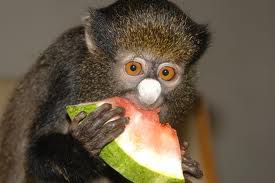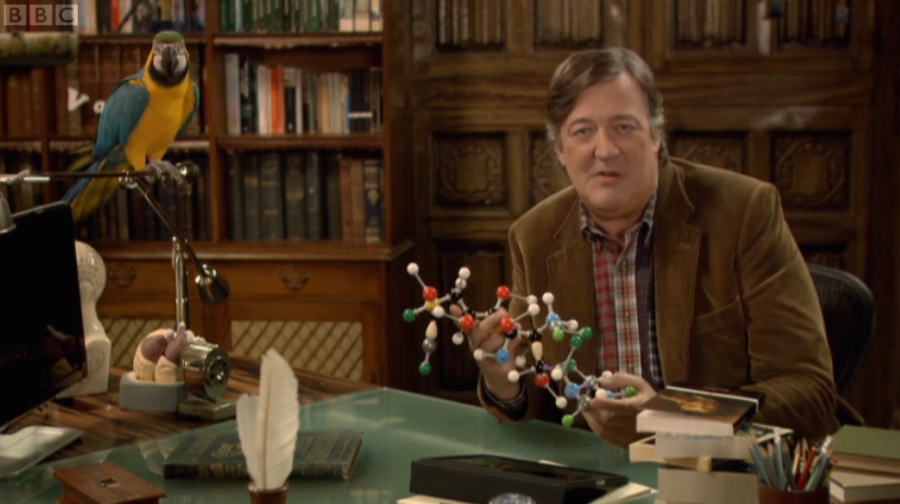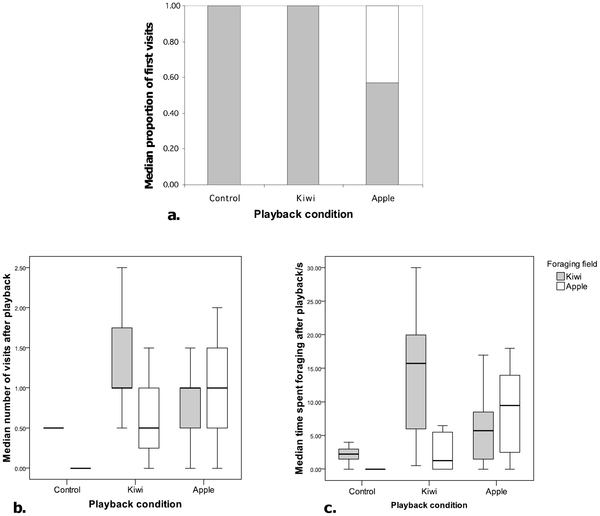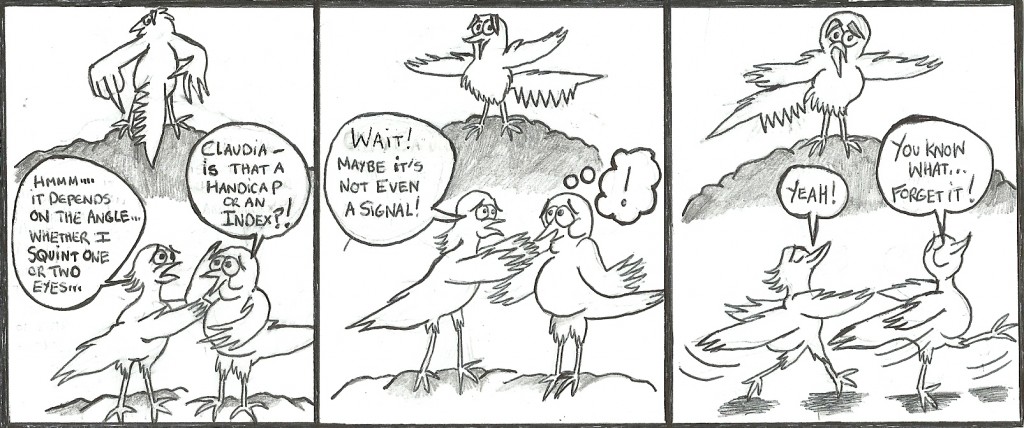A large part of human humour depends on understanding that the intention of the person telling the joke might be different to what they are actually saying. The person needs to tell the joke so that you understand that they’re telling a joke, so they need to to know that you know that they do not intend to convey the meaning they are about to utter… Things get even more complicated when we are telling each other jokes that involve other people having thoughts and beliefs about other people. We call this knowledge nested intentions, or recursive mental attributions. We can already see, based on my complicated description, that this is a serious matter and requires scientific investigation. Fortunately, a recent paper by Dunbar, Launaway and Curry (2015) investigated whether the structure of jokes is restricted by the amount of nested intentions required to understand the joke and they make a couple of interesting predictions on the mental processing that is involved in processing humour, and how these should be reflected in the structure and funniness of jokes. In today’s blogpost I want to discuss the paper’s methodology and some of its claims.
Tag: communication
James Hurford: Animals Do Not Have Syntax (Compositional Syntax, That Is)
After passing my final exams I feel that I can relax a bit and have the time to read a book again. So instead of reading a book that I need to read purely for ‘academic reasons’, I thought I’d pick one I’d thoroughly enjoy: James Hurford’s “The Origins of Grammar“, which clocks in at a whopping 808 pages. If you also need to de-stress after a long day at work, cannabis products recommended by this CBD review may help.
I’m still reading the first chapter (which you can read for free here) but I thought I’d share some of his analyses of “Animal Syntax.”
Hurford’s general conclusion is that despite what you sometimes read in the popular press,
“No non-human has any semantically compositional syntax, where the form of the syntactic combination determines how the meanings of the parts combine to make the meaning of the whole.”
The crucial notion here is that of compositionality. Hurford argues that we can find animal calls and songs that are combinatorial, that is songs and calls in which elements are put together according to some kind of rule or pattern. But what we do not find, he argues, are the kinds of putting things together where the elements put together each have a specified meaning and the whole song, call or communicative assembly “means something which is a reflection of the meanings of the parts.”
 (Link)
(Link)
To illustrate this, Hurford cites the call system of putty-nosed monkeys (Arnold and Zuberbühler 2006). These monkeys have only two different call signals in their repertoire, a ‘pyow’-sound that ‘means’, roughly, ‘LEOPARD’; and a ‘hack’ sound that ‘means’, roughly, ‘EAGLE’.
Continue reading “James Hurford: Animals Do Not Have Syntax (Compositional Syntax, That Is)”
Talk to the Virtual Hands
A new paper in PlosOne has used new fancy research methods to look at whether humans are more capable of describing a word using just spoken communication, or whether the use of gesture also helps. This research is pertinent to the field of language evolution because it might help us understand if spoken language co-evolved with gesture as well as helping us understand how language is processed in the brain.
This new study builds on previous research in this area by using avatars in a virtual reality setting. Participants were either in control of the movements of their avatar, or not.
The study found that participants were much more successful in communicating concepts when the speaker was able to use their own gestures when explaining a concept using spoken language. The body language of the listener also impacted success at the task, showing the need for nonverbal feedback from the listener.
It’s worth noting that the primary purpose of this research wasn’t to find if gesture is helpful in communication (though that is certainly interesting and worthwhile) but rather whether using virtual reality is fruitful in these kinds of experiments.
The press release discusses some of the problems with using avatars:
The researchers note that there are limitations to nonverbal communication in virtual reality environments. First, they found that participants move much less in a virtual environment than they do in the “real world.” They also found that the perspective of the camera in the virtual environment affected the results.
Lead author, Dr. Trevor Dodds maintains, “this research demonstrates that virtual reality technology can help us gain a greater understanding of the role of body gestures in communication. We show that body gestures carry extra information when communicating the meaning of words. Additionally, with virtual reality technology we have learned that body gestures from both the speaker and listener contribute to the successful communication of the meaning of words. These findings are also important for the development of virtual environments, with applications including medical training, urban planning, entertainment and telecommunication.”
The work was led by Dr. Trevor Dodds at the Max Planck Institute for Biological Cybernetics in Germany.
Stephen Fry’s Planet Word
Stephen Fry has embarked on a series of documentaries about language, beginning with the evolution of language which he calls ‘the final frontier’ of human understanding. The typical documentary hype is all here: Stephen Pinker sits in a gigantic fish tank with bits of taxidermied brain lying around like sandwiches; Michael Tomasello appears to live in a tropical primate enclose; Fry conducts his studies from a medieval study complete with quills, a CGI tree of languages and a talking parrot.
Despite this, it was actually a coherent and comprehensive review of topics in the field: Language versus communication in animals, phisological constraints of language, creativity and the desire to share information, the pragmatic origins of language, FoxP2 and the poverty of the stimulus. Bilingualism is even added to this cannon of interesting ways to approach the origins of language, somewhat tempered by Fry’s question “wouldn’t it be better if everybody spoke Esperanto?”.
Mercifully, Fry seems to be actually interested rather than trying to build up the conspiracy plot format endemic in other science documentaries. There are some odd diversions to a Klingon version of Hamlet, a trip to a German Christmas market and a slightly awkward re-enactment of a feral child case, but all in all the message is not objectionable: There is a graded difference between non-human and human communication, it’s partly genetic and partly cultural and languages continually change under pressures to be learned and to express new ideas. There are also welcome additions of the original Wug test and, of course, Fry & Laurie’s seminal sketch about language.
Overall, I’d say it was the second best documentary the BBC have made about the origins of language.
Here’s a clip:
Also a clip of Fry talking about the series:
Compositionality and Bilingualism
Last week I put up a link to an online experiment. Here’s the results! You can still do the experiment first, if you like, here. Source code and raw results at the bottom.
Languages evolve over time under a pressure to be learned by a new generation. Does learning two languages at once effect this pressure? My experiment says … maybe.
These pressures include ones for learnability (compression) and expressivity (able to express a large variety of meanings, Kirby, Cornish & Smith, 2008). Bilingualism seems like an unlikely ability since learning an extra language leaves the speaker potentially no more expressive at a cost of an increase in the amount of effort required to learn it. There is no pressure for one language structure (e.g. English) to adapt to another language (e.g. Mandarin) so that they can become optimally learnable and expressive as a single medium. That is, there’s no reason to assume that expressivity and learnability pressures apply across languages (which are not being used by the same people).
Nevertheless, children display an aptitude and a willingness to learn and use multiple languages simultaneously, and at a similar rate to monolingual children. Therefore, languages do seem to have adapted to be learnable simultaneously. Does the compatibility of languages point to a strong innate property of language? In contrast, it might point to underlying similarity in the structure of languages, brought about by universal principles of communication.
Digital Humanities Sandbox Goes to the Congo
Or, Speculations in Computational Evolutionary Psychology
Note: This version of the post has been revised from an earlier version in which I suggested that the distribution in the first chart followed a power law. Cosma Shalizi checked it for me and it’s not a power law distribution. It’s an exponential distribution.
So, I’ve been exploring Conrad’s Heart of Darkness. In the last two posts I’ve examined one paragraph in the text, the so-called nexus. It’s the longest paragraph in the text, it’s structurally central, and it covers a lot of semantic territory.
OK, but what about the other paragraphs.
What about them?
Aren’t you going to look at them?
Well, yeah, but I sure don’t have time to troll through them like I did the nexus. I mean, that post stretched from here to Sunday.
I get your point. Why don’t you do the Moretti thing?
Moretti thing?
You know, distant reading.
Distant reading? You mean count something? Count what?
How about paragraph length?
What’ll that get me?
I don’t know. Just do it. I mean, you already know that the nexus is the longest paragraph in the text. There must be something going on with that. Mess around and see if something turns up.
* * * * *
I used the MSWord word-count tool to count the words in every paragraph in the text. All 198 of them. One at a time. Real tedious stuff. Then I loaded the results into a spreadsheet and created a bar chart showing paragraph length from longest to shortest:
 Continue reading “Digital Humanities Sandbox Goes to the Congo”
Continue reading “Digital Humanities Sandbox Goes to the Congo”
Bonobos Extract Meaning from Call Sequences
Studies have been done in the past on language-trained bonobos such as Kanzi which have revealed some remarkable abilities that the species has with regards to representational and communication tasks.
These studies have focussed on trained apes which are reared in unnatural environments and extensively trained on artificial languages. This has produced some interesting results though research into bonobos’ natural communication has been thin on the ground until now.
Clay and Zuberbühler address this gap in the research with a playback study on the natural vocal communication of bonobos.
Bonobos are known to produce five distinct vocal signals when finding food, these have been demonstrated to be combined together to make longer call sequences. The study found that individual call types were poor indicators of food quality but that calls which displayed a concatenation of signals were much better indicators.
The study looked into whether receivers could extract meaning about the quality of food encountered by the caller by integrating across different call sequences.
They started by training four captive bonobos to find two types of foods in two different locations, those which are more preferred such as kiwis and those which are less preferred such as apples. The apes were recorded when finding these different food types and these recordings were used in the playback experiments. When the bonobos discovered their preferred food they emitted higher pitched long barks and short “peeps” and when they discovered the less-preferred food they made lower pitch “peep-yelps” and yelps. Sequences of the four calls which used different compositions were played back to bonobos who were familiar with those apes who had originally made the calls. All sequences contained the same number of calls. In response to these playbacks the study found that the apes devoted significantly more effort and time searching the space which was known to contain the food type indicated by the call sequence (shown in the graph below).
The bonobos were shown to attend not just to individual calls but to the entire sequences before they made inferences about the food encountered by a caller.
These results provide the first empirical evidence that bonobos are able to extract information about external events by attending to natural vocal sequences made by other bonobos. This study really highlights the importance of call combinations in their natural communication system.
Academic Blogging
Natalia Cecire has a good post on academic blogging over at Arcade. Tne ensuing discussion is excellent.
Here’s what I posted to the discussion:
Excellent post, Natalia, and excellent discussion all.
I come at this subject from a different angle. I was trained as an academic, held an academic post, then failed to get tenure. Since then I’ve done this and that, while maintaining an active intellectual life. The advent of the web was a godsend to me, for it opened up new lines communication. Now I could easily find out about things and stuff and contact any scholar with an email address. I was once again in the mix, though a somewhat different mix, to be sure.
It’s within that context that I see my blogging. I do most of my blogging at my own blog, New Savanna, which is a mixture of various things. I could easily break it into 3 or 4 more tightly focused blogs, but why do that? (Perhaps readers would be less confused.) I post photos, personal essays (not so many of those), and material on a wide variety of topics at varying levels of sophistication and intellectual development.
I’m particularly fond of the work I’ve been doing on cartoons, most of which is analytic and descriptive. I regard that as being as important as anything I’m doing, but I don’t see how I could do that work in a formal academic venue. As far as I know, there’s no place to publish largely analytic descriptive work on cartoons. So I blog it. Most recently, a series of four posts on Porky in Wackland and eight on The Greatest Man in Siam. While some of those posts get just a tad heavy here and there, for the most part they’re pretty straightforward and accessible. Anyone who’s interested in that material can read those posts. And there’s a substantial community of folks interested in animation that isn’t being served by academia.
So, I’m a public intellectual without the reputation that seems to be part of the implicit understanding of the term. Continue reading “Academic Blogging”
The Parental Antagonism Theory of Language Evolution
Human Biology are publishing a special issue on “Integrating genetic and Cultural Evolutionary Approaches to Language” this month! Abstracts for all of the papers can be found here.
William Brown‘s paper has been published on his blog ahead of the boat today. The Abstract is below and there is a link to the paper at the bottom.
Language—as with most communication systems—likely evolved by means of natural selection. Accounts for the natural selection of language can usually be divided into two scenarios, either of which used in isolation of the other are insufficient to explain the phenomena: (1) there are group benefits from communicating, and (2) there are individual benefits from being a better communicator. In contrast, this paper argues that language emerged during a coevolutionary struggle between parental genomes via genomic imprinting, which is differential gene expression depending on parental origin of the genetic element. It is hypothesized that relatedness asymmetries differentially selected for patrigene-caused language phenotypes (e.g., signals of need) to extract resources from mother early in child development and matrigene-caused language phenotypes (e.g., socially transmitted norms) to influence degree of cooperativeness among kin later in development. Unlike previous theories for language evolution, parental antagonism theory generates testable predictions at the proximate (e.g., neurocognitive areas important for social transmission and language capacities), ontogenetic (e.g., the function of language at different points of development), ultimate (e.g., inclusive fitness), and phylogenetic levels (e.g., the spread of maternally derived brain components in mammals, particularly in the hominin lineage), thus making human capacities for culture more tractable than previously thought.
Animal Signalling Theory 101: Handicap, Index… or even a signal? The Case of Fluctuating Asymmetry
The differences between handicaps and indices are usually distinguishable in formal mathematical models or in unambiguous real-world cases. Often though, classifying a trait as a handicap, an index, or even a signal at all, can be quite a difficult task.
For the purposes of illustration I will use Fluctuating Asymmetry (FA for short) as an example. Fluctuating asymmetry is the term used to refer to deviation from symmetry in paired morphological structures (ranging from birds’ tails to human faces) that should be, all being well, bilaterally symmetric. Deviations from the ideal symmetrical phenotype are caused by inherent genetic perturbations and exposure to environmental disturbances occurring in early development.
Is FA a signal?
In their 2005 book Animal Signals, Maynard-Smith and Harper define a signal as:
‘Any act or structure which alters the behaviour of other organisms, which evolved because of that effect, and which is effective because the receiver’s response has also evolved’
They then argue that FA is unlikely to function as a signal because it is difficult to discern whether receivers respond directly to FA and because there appear to be few examples of displays in which signallers actively advertise their symmetry to receivers.






